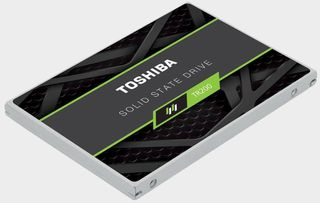Toshiba's new flash chips could lead to much higher capacity SSDs
Bigger and faster SSDs are coming.

There are some interesting things happening in the solid state drive space as of late. A little over a week ago, Samsung said it had begun mass producing its fifth generation 256Gb V-NAND flash memory that could lead to faster SSDs. Now just over a week later, Toshiba is touting a type of flash memory that could significantly increase capacities, too.
Specifically, Toshiba announced the development of a prototype sample of 96-layer BiCS flash, the company's proprietary version of 3D NAND, with 4-bit-per-cell (quad-level cell, or QLC) technology.
Why does that matter? By expanding the bit count from three to four, Toshiba's new QLC BiCS flash memory achieves a much higher capacity, topping out at 1.33 terabits (Tb) for a single chip. In a 16-die stacked architecture, that works out to 2.66 terabytes (TB).
Now consider an SSD with multiple stacked structures inside. According to Engadget, this development could boost the capacity of SSDs by 500 percent. That's probably a bit optimistic, as there are other challenges to deal with besides just raw capacity. However, this is the type of thing that could make larger capacity SSDs more affordable.
This could happen sooner than later. In a separate announcement, Western Digital said it has started sampling 96-layer 3D NAND to clients, and is doing so in volume. WD also alluded to better pricing.
"With the best intrinsic cost structure of any NAND product, BiCS4 underscores our strengths in developing flash innovations that allow our customers’ data to thrive across retail, mobile, embedded, client and enterprise environments. We expect the four-bits-per-cell technology will find mainstream use in all these applications," WD said.
As for performance, TLC was initially quite a bit slower than MLC NAND, and the move to QLC increases complexity and will almost certainly reduce write speeds. Will the 33 percent increase in capacity offset the potentially lower performance? Our best guess is that we will see SSDs using 96-layer 3D NAND chips, both with and without QLC, before the end of the year.
The biggest gaming news, reviews and hardware deals
Keep up to date with the most important stories and the best deals, as picked by the PC Gamer team.
Paul has been playing PC games and raking his knuckles on computer hardware since the Commodore 64. He does not have any tattoos, but thinks it would be cool to get one that reads LOAD"*",8,1. In his off time, he rides motorcycles and wrestles alligators (only one of those is true).
Most Popular






